Foren > Spieltricks und -tipps
Ein einfacher Satz von Formeln für Magic Cube
von Novel Games
2008-01-10 15:50:51
#1

(Übersetzt von Microsoft) Es gibt viele Möglichkeiten, Rubiks Würfel zu lösen, aber sie alle beinhalten die Verwendung von Formeln, um die Blöcke zu verschieben. Einige Lösungen erfordern die Verwendung von mehr als 50 Formeln, die ziemlich schwierig zu erlernen ist. Im Folgenden finden Sie einen Satz von 3 Formeln, die von Dem verstorbenen Mr. Ngai Shing Lee erfunden wurden, und dieser Satz von Formeln ist leicht zu erlernen und sich daran zu erinnern. Beachten Sie, dass viele Bewegungen erforderlich sind und Sie das Rätsel nicht extrem schnell lösen können, aber schließlich werden Sie in der Lage sein, es zu lösen.
Das Grundkonzept ist es, zuerst die Ecken und dann die Kanten zu lösen. Dies basiert auf einer einfachen Beobachtung, dass das Verschieben der mittleren Reihen allein die Ecken nicht stören wird.
Das grundlegende Verfahren ist wie folgt:
Beginnen Sie nun mit Formel A, die die Positionen von 3 Eckblöcken tauscht:
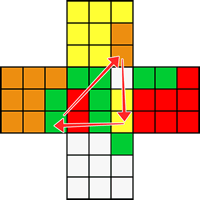
(Zur einfachen Demonstration beginnt das oben gezeigte Ergebnis mit einem gelösten Cube)
Die Formel A geht wie folgt:
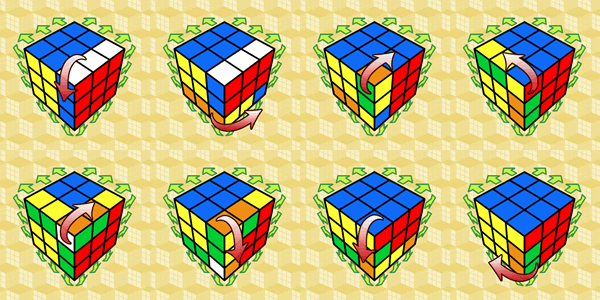
Beachten Sie, dass die ersten 3 Schritte das Entfernen der unteren rechten Ecke der oberen Fläche beinhalten und die restlichen Schritte darin bestehen, sie wieder zu setzen. Sie können auch eine Variante dieser Formel anwenden, die die untere linke Ecke der oberen Fläche entfernt und zurücksetzt, um einen ähnlichen Effekt für die oberen linken, unteren linken und unteren rechten Blöcke auf der unteren rechten Seite zu erzielen.
Nachdem Sie die Eckblöcke der unteren Fläche in ihre richtigen Positionen (aber nicht unbedingt in den richtigen Ausrichtungen) verschoben haben, können Sie Formel B anwenden, um die Blöcke gegen den Uhrzeigersinn zu drehen:
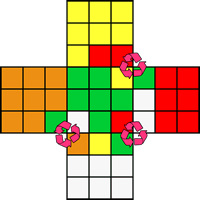
Formel B geht wie folgt:
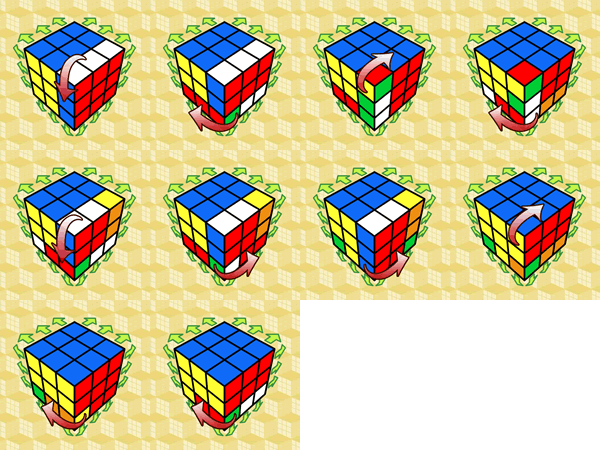
Beachten Sie, dass die ersten 3 Schritte das Entfernen der unteren rechten Ecke der oberen Fläche beinhalten und die restlichen Schritte darin bestehen, sie wieder zu setzen. Wenn Sie eine Variante dieser Formel anwenden, werden die oberen linken, unteren linken und unteren rechten Blöcke in der unteren Fläche im Uhrzeigersinn gedreht.
Nachdem Sie alle 8 Ecken fertig gestellt haben, sollten Sie die Kanten mit Formel C behandeln, die die Positionen von 3 Blöcken auf der Kante gegen den Uhrzeigersinn tauscht:
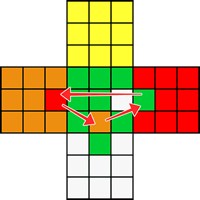
Die Formel C geht wie folgt vor:
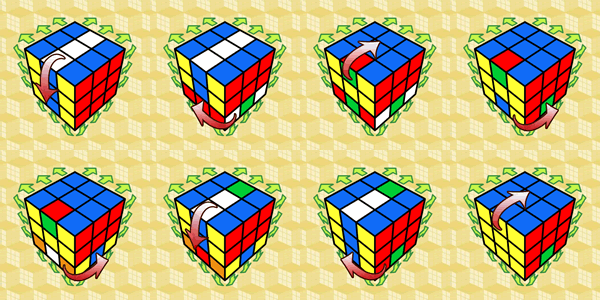
Beachten Sie, dass die ersten 3 Schritte das Entfernen des unteren mittleren Blocks beinhalten und die restlichen Schritte darin bestehen, ihn zurückzustellen. Sie können auch eine Variante dieser Formel anwenden, um die Positionen der Blöcke im Uhrzeigersinn zu tauschen, indem Sie die linke und rechte Drehung wie oben gezeigt tauschen.
Wenn Sie Formel C verwenden, treten Sie manchmal vor der Situation, dass sich die falschen Blöcke nicht auf derselben Fläche befinden, und in diesem Fall müssen Sie zusätzliche Bewegungen vornehmen, um die falschen Blöcke auf dieselbe Fläche zu verschieben, bevor Sie Formel C anwenden.
Das Grundkonzept ist es, zuerst die Ecken und dann die Kanten zu lösen. Dies basiert auf einer einfachen Beobachtung, dass das Verschieben der mittleren Reihen allein die Ecken nicht stören wird.
Das grundlegende Verfahren ist wie folgt:
- Verschieben Sie die vier Ecken einer Fläche an ihre richtigen Positionen und richtigen Ausrichtungen (Dafür sollten Sie keine Formeln benötigen)
- Verwenden Sie Formel A, um die verbleibenden vier Ecken an ihre richtigen Positionen zu verschieben, aber nicht unbedingt in den richtigen Ausrichtungen.
- Verwenden Sie Formel B, um die verbleibenden Eckblöcke in ihre richtige Ausrichtung zu drehen. Jetzt sollten alle acht Ecken stimmen
- Verwenden Sie Formel C, um die Kanten an ihre richtigen Positionen zu verschieben
Beginnen Sie nun mit Formel A, die die Positionen von 3 Eckblöcken tauscht:

(Zur einfachen Demonstration beginnt das oben gezeigte Ergebnis mit einem gelösten Cube)
Die Formel A geht wie folgt:

Beachten Sie, dass die ersten 3 Schritte das Entfernen der unteren rechten Ecke der oberen Fläche beinhalten und die restlichen Schritte darin bestehen, sie wieder zu setzen. Sie können auch eine Variante dieser Formel anwenden, die die untere linke Ecke der oberen Fläche entfernt und zurücksetzt, um einen ähnlichen Effekt für die oberen linken, unteren linken und unteren rechten Blöcke auf der unteren rechten Seite zu erzielen.
Nachdem Sie die Eckblöcke der unteren Fläche in ihre richtigen Positionen (aber nicht unbedingt in den richtigen Ausrichtungen) verschoben haben, können Sie Formel B anwenden, um die Blöcke gegen den Uhrzeigersinn zu drehen:

Formel B geht wie folgt:

Beachten Sie, dass die ersten 3 Schritte das Entfernen der unteren rechten Ecke der oberen Fläche beinhalten und die restlichen Schritte darin bestehen, sie wieder zu setzen. Wenn Sie eine Variante dieser Formel anwenden, werden die oberen linken, unteren linken und unteren rechten Blöcke in der unteren Fläche im Uhrzeigersinn gedreht.
Nachdem Sie alle 8 Ecken fertig gestellt haben, sollten Sie die Kanten mit Formel C behandeln, die die Positionen von 3 Blöcken auf der Kante gegen den Uhrzeigersinn tauscht:

Die Formel C geht wie folgt vor:

Beachten Sie, dass die ersten 3 Schritte das Entfernen des unteren mittleren Blocks beinhalten und die restlichen Schritte darin bestehen, ihn zurückzustellen. Sie können auch eine Variante dieser Formel anwenden, um die Positionen der Blöcke im Uhrzeigersinn zu tauschen, indem Sie die linke und rechte Drehung wie oben gezeigt tauschen.
Wenn Sie Formel C verwenden, treten Sie manchmal vor der Situation, dass sich die falschen Blöcke nicht auf derselben Fläche befinden, und in diesem Fall müssen Sie zusätzliche Bewegungen vornehmen, um die falschen Blöcke auf dieselbe Fläche zu verschieben, bevor Sie Formel C anwenden.
(Original) A Simple Set of Formulas for Magic Cube
There are many ways to solve Rubik's Cube, but they all involve the use of formulas to move the blocks. Some solutions require the use of more than 50 formulas which is rather difficult to learn. The following is a set of 3 formulas invented by late Mr. Ngai Shing Lee, and this set of formulas is easy to learn and remember. Note that a lot of moves is needed and you cannot solve the puzzle extremely quickly, but eventually you will be able to solve it.
The basic concept is to solve the corners first and then the edges. This is based on a simple observation that moving the middle rows alone will not disrupt the corners.
The basic procedure is as follows:
Now start with formula A, which swaps the positions of 3 corner blocks:

(For easy demonstration, the result shown above is starting with a solved cube)
Formula A goes as follows:

Note that the first 3 steps involve the removal of the lower right corner of the top face, and the remaining steps are to put it back. You can also apply a variation of this formula which removes and puts back the lower left corner of the top face to achieve a similar effect for the top left, bottom left and bottom right blocks on the bottom face.
After you have finished moving the corner blocks of the bottom face to their correct positions (but not necessarily in correct orientations), you can apply formula B to rotate the blocks counterclockwise:

Formula B goes as follows:

Note that the first 3 steps involve the removal of the lower right corner of the top face, and the remaining steps are to put it back. If you apply a variation of this formula, the top left, bottom left and bottom right blocks in the bottom face will be rotated clockwise.
After you have finished all the 8 corners, you should deal with the edges using formula C, which swaps the positions of 3 blocks on the edge in a counterclockwise direction:

Formula C goes as follows:

Note that the first 3 steps involve the removal of the lower middle block, and the remaining steps are to put it back. You can also apply a variation of this formula to swap the positions of the blocks in a clockwise direction by swapping the left and right rotations as shown above.
When using formula C, sometimes you will face a situation that the incorrect blocks are not on the same face, and in this case you will need to make extra moves to move the incorrect blocks to the same face before applying formula C.
There are many ways to solve Rubik's Cube, but they all involve the use of formulas to move the blocks. Some solutions require the use of more than 50 formulas which is rather difficult to learn. The following is a set of 3 formulas invented by late Mr. Ngai Shing Lee, and this set of formulas is easy to learn and remember. Note that a lot of moves is needed and you cannot solve the puzzle extremely quickly, but eventually you will be able to solve it.
The basic concept is to solve the corners first and then the edges. This is based on a simple observation that moving the middle rows alone will not disrupt the corners.
The basic procedure is as follows:
- Move the four corners of one face to their correct positions and correct orientations (you should not need any formulas for this)
- Use formula A to move the remaining four corners to their correct positions but not necessarily in correct orientations
- Use formula B to rotate the remaining corner blocks to their correct orientations. Now all eight corners should be correct
- Use formula C to move the edges to their correct positions
Now start with formula A, which swaps the positions of 3 corner blocks:

(For easy demonstration, the result shown above is starting with a solved cube)
Formula A goes as follows:

Note that the first 3 steps involve the removal of the lower right corner of the top face, and the remaining steps are to put it back. You can also apply a variation of this formula which removes and puts back the lower left corner of the top face to achieve a similar effect for the top left, bottom left and bottom right blocks on the bottom face.
After you have finished moving the corner blocks of the bottom face to their correct positions (but not necessarily in correct orientations), you can apply formula B to rotate the blocks counterclockwise:

Formula B goes as follows:

Note that the first 3 steps involve the removal of the lower right corner of the top face, and the remaining steps are to put it back. If you apply a variation of this formula, the top left, bottom left and bottom right blocks in the bottom face will be rotated clockwise.
After you have finished all the 8 corners, you should deal with the edges using formula C, which swaps the positions of 3 blocks on the edge in a counterclockwise direction:

Formula C goes as follows:

Note that the first 3 steps involve the removal of the lower middle block, and the remaining steps are to put it back. You can also apply a variation of this formula to swap the positions of the blocks in a clockwise direction by swapping the left and right rotations as shown above.
When using formula C, sometimes you will face a situation that the incorrect blocks are not on the same face, and in this case you will need to make extra moves to move the incorrect blocks to the same face before applying formula C.
von Novel Games
2008-01-10 15:50:51
Gefällt mir
Antworten
Eine Antwort posten
Wird übermittelt ...
Posten der Antwort ist fehlgeschlagen. Bitte noch einmal versuchen. Beenden